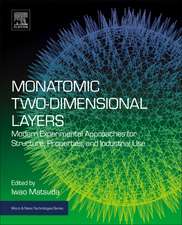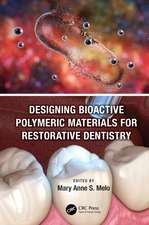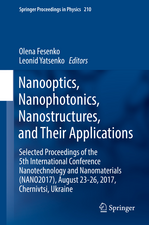DNA Nanoscience: From Prebiotic Origins to Emerging Nanotechnology
Autor Kenneth Douglasen Limba Engleză Hardback – 9 aug 2017
Preț: 1042.56 lei
Preț vechi: 1404.21 lei
-26% Nou
Puncte Express: 1564
Preț estimativ în valută:
199.52€ • 206.11$ • 166.05£
199.52€ • 206.11$ • 166.05£
Carte tipărită la comandă
Livrare economică 26 martie-09 aprilie
Preluare comenzi: 021 569.72.76
Specificații
ISBN-13: 9781138453333
ISBN-10: 1138453331
Pagini: 456
Dimensiuni: 178 x 254 mm
Greutate: 0.45 kg
Ediția:1
Editura: CRC Press
Colecția CRC Press
Locul publicării:Boca Raton, United States
ISBN-10: 1138453331
Pagini: 456
Dimensiuni: 178 x 254 mm
Greutate: 0.45 kg
Ediția:1
Editura: CRC Press
Colecția CRC Press
Locul publicării:Boca Raton, United States
Recenzii
‘DNA Nanosciencetakes us on a journey into the future, where sub-microscopic gadgets built from DNA may be used to detect specific molecules one-at-a-time or to deliver therapeutic drugs specifically to cancer cells. Looking in the other direction, the journey takes us back 4 billion years to a time when the self-organization of DNA into liquid crystals may have facilitated the reproduction of what would become our genetic material, arguably the key step in the origin of life.
DNA Nanoscienceis scholarly and full of technical figures. But the science is accompanied by clear explanations that make it accessible to college student and science-savvy citizens. It is a pleasure to find a book that is so true to the science while being so enjoyable to read.’
– Thomas R. Cech
Distinguished Professor, University of Colorado-Boulder; Director, BioFrontiers Institute; Nobel Laureate (Chemistry 1989).
‘Douglas’ DNA Nanoscience is something of a miracle.’
– Stuart Kauffman
Emeritus Professor Biochemistry and Biophysics, University of Pennsylvania; Affiliate Professor, The Institute for Systems Biology, Seattle; Author of At Home in the Universe.
‘This book changed my life. Every seven years, as my sabbatical approaches, I search about for a new direction to focus my research and Ken Douglas’ book, DNA Nanoscience, appeared just in time.’
– Seth Fraden
Professor of Physics; Director, The Bioinspired Soft Materials Center, Brandeis University.
‘Instructive like a textbook and exciting like a novel! For everybody interested in modern natural sciences, this book is a must to read.’
– Andreas Herrmann
Professor of Polymer Chemistry and Bioengineering; Chair of the Board, The Zernike Institute for Advanced Materials; University of Groningen, The Netherlands.
‘To sum up, this is both a lively and profound book, the reading of which I strongly recommend.’
– Jacques Prost
Director Emeritus of CNRS (Le Centre national de la recherche scientifique) at Institut Curie, Paris; Distinguished Professor, National University of Singapore.
‘This book tells a fascinating new story about DNA. The subject matter also stretches as needed into biology to teach basic ideas about cell membranes and metabolism. It provides a wonderful taste of DNA nanoscience at the research frontier.’
– Arjun G. Yodh
James M. Skinner Professor of Science, Endowed Chair; Director, PENN Laboratory for Research on the Structure of Matter, University of Pennsylvania.
‘The only way that the general public will continue to trust the proclamation of the scientific establishment is through books like this one – where the foibles and fears and eccentricities of the scientists are shown to be the same as those of the artist, musician and businessman. Scientists are just artists who want to work with mother nature, without the freedom to make up new worlds as we go along. The real world is magical enough for them.’
– Joseph A. Zasadzinski
3M Harry Heltzer Chair in Multidisciplinary Science and Technology; Chemical Engineering and Materials Science, University of Minnesota.
'The book’s eclectic and elaborate vision, looking back to the ancient past and forward to the equally unknowable future sets Douglas’ DNA Nanoscience apart from other attempts to present DNA nanoscience.... Written in beautiful prose and richly illustrated with over 200 full-color figures ... it also serves as a bird’s-eye survey for a more general readership, viz., for those in the public who are curious and enjoy thinking. These citizens are aware of DNA nanoscience snippets making it into the daily news but would like to acquire a deeper, more meaningful and thorough understanding of what the fuss is all about.
Douglas’ book DNA Nanoscience: From Prebiotic Origins to Emerging Nanotechnology covers an astoundingly broad ground.... By writing this book on the emerging field of DNA nanoscience Kenneth Douglas has thus done a double service—to science as well as to its public image. I believe that the reception of the book will do justice to the meticulous research and artistry of this tome.'
– Rudolf Podgornik (Jožef Stefan Institute)
Journal of Biological Physics (August 2016), DOI: 10.1007/s10867-016-9425-4.
DNA Nanoscienceis scholarly and full of technical figures. But the science is accompanied by clear explanations that make it accessible to college student and science-savvy citizens. It is a pleasure to find a book that is so true to the science while being so enjoyable to read.’
– Thomas R. Cech
Distinguished Professor, University of Colorado-Boulder; Director, BioFrontiers Institute; Nobel Laureate (Chemistry 1989).
‘Douglas’ DNA Nanoscience is something of a miracle.’
– Stuart Kauffman
Emeritus Professor Biochemistry and Biophysics, University of Pennsylvania; Affiliate Professor, The Institute for Systems Biology, Seattle; Author of At Home in the Universe.
‘This book changed my life. Every seven years, as my sabbatical approaches, I search about for a new direction to focus my research and Ken Douglas’ book, DNA Nanoscience, appeared just in time.’
– Seth Fraden
Professor of Physics; Director, The Bioinspired Soft Materials Center, Brandeis University.
‘Instructive like a textbook and exciting like a novel! For everybody interested in modern natural sciences, this book is a must to read.’
– Andreas Herrmann
Professor of Polymer Chemistry and Bioengineering; Chair of the Board, The Zernike Institute for Advanced Materials; University of Groningen, The Netherlands.
‘To sum up, this is both a lively and profound book, the reading of which I strongly recommend.’
– Jacques Prost
Director Emeritus of CNRS (Le Centre national de la recherche scientifique) at Institut Curie, Paris; Distinguished Professor, National University of Singapore.
‘This book tells a fascinating new story about DNA. The subject matter also stretches as needed into biology to teach basic ideas about cell membranes and metabolism. It provides a wonderful taste of DNA nanoscience at the research frontier.’
– Arjun G. Yodh
James M. Skinner Professor of Science, Endowed Chair; Director, PENN Laboratory for Research on the Structure of Matter, University of Pennsylvania.
‘The only way that the general public will continue to trust the proclamation of the scientific establishment is through books like this one – where the foibles and fears and eccentricities of the scientists are shown to be the same as those of the artist, musician and businessman. Scientists are just artists who want to work with mother nature, without the freedom to make up new worlds as we go along. The real world is magical enough for them.’
– Joseph A. Zasadzinski
3M Harry Heltzer Chair in Multidisciplinary Science and Technology; Chemical Engineering and Materials Science, University of Minnesota.
'The book’s eclectic and elaborate vision, looking back to the ancient past and forward to the equally unknowable future sets Douglas’ DNA Nanoscience apart from other attempts to present DNA nanoscience.... Written in beautiful prose and richly illustrated with over 200 full-color figures ... it also serves as a bird’s-eye survey for a more general readership, viz., for those in the public who are curious and enjoy thinking. These citizens are aware of DNA nanoscience snippets making it into the daily news but would like to acquire a deeper, more meaningful and thorough understanding of what the fuss is all about.
Douglas’ book DNA Nanoscience: From Prebiotic Origins to Emerging Nanotechnology covers an astoundingly broad ground.... By writing this book on the emerging field of DNA nanoscience Kenneth Douglas has thus done a double service—to science as well as to its public image. I believe that the reception of the book will do justice to the meticulous research and artistry of this tome.'
– Rudolf Podgornik (Jožef Stefan Institute)
Journal of Biological Physics (August 2016), DOI: 10.1007/s10867-016-9425-4.
Notă biografică
Kenneth Douglas is a member of the Research Faculty in the Department of Physics at the University of Colorado-Boulder. He received his B.A. (mathematics) and M.S. (physics) at the University of Chicago and his Ph.D. (physics) at the University of Colorado-Boulder. His area of specialization is biomimetic nanofabrication. He devised a strategy that employs the surface layers of bacterial extremophiles — e.g., Sulfolobus acidocaldarius — as masks to fabricate nanoscale periodic patterns on inorganic substrates. He is co-inventor of the first-ever U.S. patents for parallel fabrication of nanoscale multi-device structures. His work has appeared in Science, Nature, Biophysical Journal, Applied Physics Letters, Physical Review B, Surface Science, FEMS Microbiology Reviews, Journal of Applied Physics, Popular Science and elsewhere. Douglas has authored multiple book chapters and seven U.S. patents.
Descriere
Quick and Easy Access to Key Elements of Documentation Includes worked examples across a wide variety of applications, tasks, and graphicsA unique companion for statistical coders, Using SAS for Data Management, Statistical Analysis, and Graphics presents an easy way to learn how to perform an analytical task in SAS, without having to navigate through the extensive, idiosyncratic, and sometimes unwieldy software documentation. Organized by short, clear descriptive entries, the book covers many common tasks, such as data management, descriptive summaries, inferential procedures, regression analysis, multivariate methods, and the creation of graphics. Through the extensive indexing, cross-referencing, and worked examples in this text, users can directly find and implement the material they need. The text includes convenient indices organized by topic and SAS syntax. Demonstrating the SAS code in action and facilitating exploration, the authors present example analyses that employ a single data set from the HELP study. They also provide several case studies of more complex applications. Data sets and code are available for download on the book‘s website. Helping to improve your analytical skills, this book lucidly summarizes the features of SAS most often used by statistical analysts. New users of SAS will find the simple approach easy to understand while more expert SAS programmers will appreciate the invaluable source of task-oriented information.

























